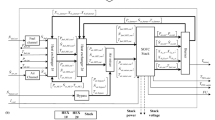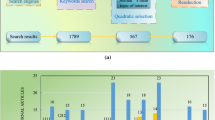Abstract
One of the key problems for a solid oxide fuel cell (SOFC), which is a high-temperature power-generation plant, is the cooperative control of safe operation and system efficiency during load tracking. Within the constraints of thermal safety, the SOFC plant should have the maximum output efficiency under various static conditions. Moreover, the SOFC system can switch between different static working conditions smoothly, safely, and quickly when the external load power changes. To achieve cooperative thermoelectric control, taking a 5-kW stand-alone SOFC system as the research object, according to the optimal static strategy designed based on the optimal operating curves (OOCs), a sliding mode controller (SMC) is designed and the closed-loop responses are discussed for SOFC system power switching during load tracking. The identification results demonstrate that the electrical coupling dynamic model can depict and predict accurately the electrical characteristics of SOFC stacks. And based on the obtained OOCs, the thermoelectric control can be achieved and thermal safety ensured using the designed SMC.














Similar content being viewed by others
Abbreviations
- AR :
-
air excess ratio [−]
- BP :
-
bypass valve opening ratio [−]
- C :
-
specific heat capacity [kJ kmol−1 K−1]
- △E 0 :
-
standard electrode potential (V)
- FU :
-
fuel utilization [−]
- F :
-
Faraday’s constant [96,485 C mol−1]
- h :
-
convective heat transfer coefficient [kW cm−2 K−1]
- I :
-
current [A]
- LHV :
-
low heat value [kJ]
- Max. |ΔT PEN|:
-
maximum PEN temperature gradient [K cm−1]
- Max. T PEN :
-
maximum PEN temperature [K]
- N :
-
control volume mole number [kmol]
- \( \dot{N} \) :
-
molar flow rate [kmol s−1]
- N 0 :
-
number of fuel cells [−]
- p :
-
pressure [bar]
- k :
-
thermal conductivity [kW cm−1 K−1]
- P :
-
power [kW]
- \( \dot{Q} \) :
-
heat transfer [kW]
- R :
-
universal gas constant [8.314 kJ kmol−1 K−1]
- A :
-
surface area [cm2]
- T :
-
temperature [K]
- U :
-
voltage [V]
- \( \dot{W} \) :
-
work [W]
- X :
-
species mole fraction
- L :
-
distance between control volume [cm]
- C D :
-
current density [A cm−2]
- i 0 :
-
exchange current [A cm−2]
- S node :
-
area of each node [cm2]
- LSM:
-
lanthanum strontium manganate
- j :
-
the index of discretization units of the cell
- J :
-
the user-defined number of cell nodes
- τ :
-
effectiveness
- γ :
-
specific heat ratio, 1.4
- δ :
-
number of electrons participating in the electro-chemical reaction
- α :
-
charge transfer coefficient, 0.5
- ε :
-
specified tolerance constant, 1e−5
- η :
-
efficiency [%]
- amb:
-
ambient
- act:
-
activation
- B:
-
burner
- bl:
-
blower
- by:
-
bypass
- con:
-
concentration
- dl:
-
diagonal line
- i :
-
species
- in:
-
inlet
- out:
-
outlet
- net:
-
system net output power
- s:
-
stack
- v:
-
volume
- so:
-
solid control volume
- ga:
-
gas control volume
- ca:
-
cathode
- an:
-
anode
- PEN:
-
positive electrode-electrolyte-negative electrode
References
Minh NQ, Takahashi T (1995) Sci Technol of Ceramic Fuel Cell Elsevier, Amsterdam
Vielstich W, Yokokawa H, Gasteiger HA (2009) Handbook of fuel cells: fundamentals technology and applications. John Wiley &Sons
Qi Y, Huang B, Luo J (2006) Dynamic modeling of a finite volume of solid oxide fuel cell: the effect of transport dynamics. Chem Eng Sci 61(18):6057–6076
Rees NV, Compton RG (2011) Sustainable energy: a review of formic acid electrochemical fuel cells. J Solid State Electrochem 15(10):2095–2100
Dillig M, Plankenbühler T, Karl J (2018) Thermal effects of planar high temperature heat pipes in solid oxide cell stacks operated with internal methane reforming. J Power Sources 373:139–149
Zhang T, Feng G (2009) Rapid load following of an SOFC power system via stable fuzzy predictive tracking controller. IEEE Trans Fuzzy Syst 17(2):357–371
Hames Y, Kaya K, Baltacioglu E, Turksoy A (2018) Analysis of the control strategies for fuel saving in the hydrogen fuel cell vehicles. Int J Hydrog Energy Doi: https://doi.org/10.1016/j.ijhydene.2017.12.150
Stiller C, Thorud B, Bolland O, Kandepu R, Imsland L (2006) Control strategy for a solid oxide fuel cell and gas turbine hybrid system. J Power Sources 158(1):303–315
Jia Z, Sun J, Oh SR, Dobbs H, King J (2013) Control of the dual mode operation of generator/motor in SOFC/GT-based APU for extended dynamic capabilities. J Power Sources 235:172–180
M. F (2008) The dynamics and control of integrated solid oxide fuel cell systems: transient load-following and fuel disturbance rejection. Ph.D Thesis, University of California, Irvine
Wang YZ, Yu J, Weng S (2011) Numerical investigation of different loads effect on the performance of planar electrode supported SOFC with syngas as fuel. Int J Hydrog Energy 36(9):5624–5631
Barelli L, Bidini G, Gallorini F, Ottaviano PA (2013) Design optimization of a SOFC-based CHP system through dynamic analysis. Int J Hydrog Energy 38(1):354–369
Xi HD (2007) Dynamic modeling and control of planar SOFC power system. Ph.D Thesis, University of Michigan, Ann Arbor
Padulles J, Ault GW, McDonald JR (2000) An integrated SOFC plant dynamic model for power systems simulation. J Power Sources 86(1-2):495–500
Xie Y, Xue X (2009) Transient modeling of anode-supported solid oxide fuel cells. Int J Hydrog Energy 34(16):6882–6891
Kazempoor P, Dorer V, Ommi F (2009) Evaluation of hydrogen and methane-fuelled solid oxide fuel cell systems for residential applications: system design alternative and parameter study. Int J Hydrog Energy 34(20):8630–8644
Cao H, Li X, Deng Z, Li J, Qin Y (2013) Thermal management oriented steady state analysis and optimization of a kW scale solid oxide fuel cell stand-alone system for maximum system efficiency. Int J Hydrog Energy 38(28):12404–12417
Wu X, Ye Q, Wang J (2017) A hybrid prognostic model applied to SOFC prognostics. Int J Hydrog Energy 42(39):25008–25020
Murshed AM, Huang B, Nandakumar K (2007) Control relevant modeling of planer solid oxide fuel cell system. J Power Sources 163(2):830–845
Mueller F, Brouwer J, Jabbari F, Samuelsen S (2006) Dynamic simulation of an integrated solid oxide fuel cell system including current-based fuel flow control. J Fuel Cell Sci Technol 3(2):144–154
Komatsu Y, Brus G, Kimijima S, Szmyd J (2014) The effect of overpotentials on the transient response of the 300W SOFC cell stack voltage. Appl Energy 115:352–359
Zhang L, Li X, Jiang JH, Li SH, Yang J, Li J (2015) Dynamic modeling and analysis of a 5-kW solid oxide fuel cell system from the perspectives of cooperative control of thermal safety and high efficiency. Int J Hydrog Energy 40(1):456–476
Zhang L, Jiang J, Cheng H, Deng ZH, Li X (2015) Control strategy for power management, efficiency-optimization and operating-safety of a 5-kW solid oxide fuel cell system. Electrochim Acta 177:237–249
Bao C, Wang Y, Feng D, Jiang Z, Zhang X (2018) Macroscopic modeling of solid oxide fuel cell (SOFC) and model-based control of SOFC and gas turbine hybrid system. Prog Energy Combust Sci 66:83–140
Ramadhani F, Hussain MA, Mokhlis H, Hajimolana S (2017) Optimization strategies for Solid Oxide Fuel Cell (SOFC) application: a literature survey. Renew Sust Energ Rev 76:460–484
Papurello D, Iafrate C, Lanzini A, Santarelli M (2017) Trace compounds impact on SOFC performance: experimental and modelling approach. Appl Energy 208:637–654
Wang Y, Gu L, Gao M, Zhu K (2016) Multivariable output feedback adaptive terminal sliding mode control for underwater vehicles. Asian J Control 18(1):247–265
Utkin V, Guldner J, Shi J, Ge S, Lewis F (2009) Sliding mode control in electro-mechanical systems, Second Edition. Boca Raton: CRC Press
Funding
The work was supported by the open fund project of Hubei Province Key Laboratory of Intelligent Information Processing and Real-time Industrial System (No. znxx2018ZD02), the basic research project of Shenzhen (JCYJ20170307160923202), and the National Natural Science Foundation of China (61573162).
Author information
Authors and Affiliations
Corresponding author
Appendix
Appendix
Detailed expressions of SOFC operating parameters, thermal temperature constraints, and electrical outputs.
Operating parameters
Thermal temperature constraints
Electrical outputs
Rights and permissions
About this article
Cite this article
Zhang, L., Shi, S., Jiang, J. et al. An optimization and fast load-oriented control for current-based solid oxide fuel cell system. J Solid State Electrochem 22, 2863–2877 (2018). https://doi.org/10.1007/s10008-018-3996-x
Received:
Revised:
Accepted:
Published:
Issue Date:
DOI: https://doi.org/10.1007/s10008-018-3996-x




